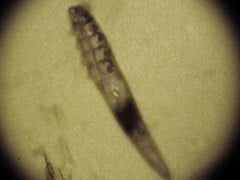Please enjoy a few sample questions to help you prepare for the Veterinary Technician National Examination! VetTechPrep.com is the most comprehensive resource you will find on preparation for the VTNE exam. The site covers the categories you will find on the exam, and also includes PowerPages, which are condensed notes on important board review topics.
Scroll down to the very bottom for the correct answers and explanations. For access to the full database of study materials, visit www.VetTechPrep.com
POP QUIZ:
Question1: Bacteria differ from animal cells in which of the following ways?
a) They lack ribonucleic acid
b) They lack cell walls
c) They are unable to metabolize glucose
d) They lack a true membrane-bound nucleus
Question 2: A cigar-shaped mite that is seen on a skin scraping from a dog with severe generalized skin lesions is probably what type of mite?

a) Sarcoptes
b) Cnemidocoptes
c) Otodectes
d) Demodex
e) Notoedres
Question 3: A patient under anesthesia is hypoventilating and the end-tidal CO2 is rising. The doctor instructs you to give the patient a breath. The pressure on the manometer to which you ventilate the patient is:
a) 20 cm H2O
b) 5 cm H2O
c) 40 cm H2O
d) 60 cm H2O
Question 4: In a pregnant mare, "red bag" delivery implies what situation?
a) Delivery of a premature foal
b) Rupture of the amniotic sac
c) Rupture of the chorioallantois
d) Premature placental separation
Question 5: What type of estrous cycle does the cow have?
a) Estrus every 6 months
b) Polyestrous in the fall
c) Non-seasonal polyestrous
d) Induced ovulation when bred
Question 6: How many upper incisors does a goat have?
a) Six
b) Four
c) Zero
d) One
e) Two
ANSWERS AND EXPLANATIONS TO QUESTIONS:
Question 1: Correct answer: D
Bacteria are referred to as prokaryotes because they lack a true membrane-bound nucleus. Animals, as well as all multi-cellular organisms, are known as eukaryotes since they have a membrane-bound nucleus. Bacteria do have ribonucleic acids, and several antibiotics target transcription of mRNA. Bacteria are able to metabolize glucose. The type of cell wall that a bacterium has helps us differentiate whether it is a Gram-positive or Gram-negative organism.
Question 2: Correct answer: D
Demodex is the cigar-shaped mite. The other mites are much rounder. The generalized skin lesions are not specific for Demodex as they can also be seen with Sarcoptes.
Question 3: Correct answer: A
When inflating the lungs, the pressure should reach but not exceed 20 cm H2O.
Question 4: Correct answer: D
Red bag is the layman's term for premature separation of the chorioallantois from the placenta and is a medical emergency. The chorioallantois interfaces with the mare's endometrium and is the interface that transfers oxygen to the fetus. Under normal circumstances, the fetus breaks through the chorioallantois at the cervical star, and the fetus and amniotic sac are delivered first. In a red bag delivery, the entire fetal-placental unit is being delivered all at once and thus can cut off the oxygen supply to the fetus prior to birth; this can result in death of the fetus if parturition is not facilitated immediately.
Question 5: Correct answer: C
Cows have non-seasonal polyestrous cycles. This means that they have estrus cycles year round. Average estrus is 21 days and lasts for 18 to 24 hours, but heat stress can shorten this window. Estrus is the time of "standing heat" when the cow will stand to be mounted by the bull. Sheep are polyestrous in the fall. Cats are induced ovulators.
Question 6: Correct answer: C
Goats have no upper front teeth (incisors); their upper front mouth is one big gumline. In the back on their mouth they do have both upper and lower teeth. Goats are born with teeth which are replaced by permanent teeth as they age.
The dental formula for permanent teeth in the goat is:
2 ( I 0/3 C 0/1 P 3/3 M 3/3) = 32


